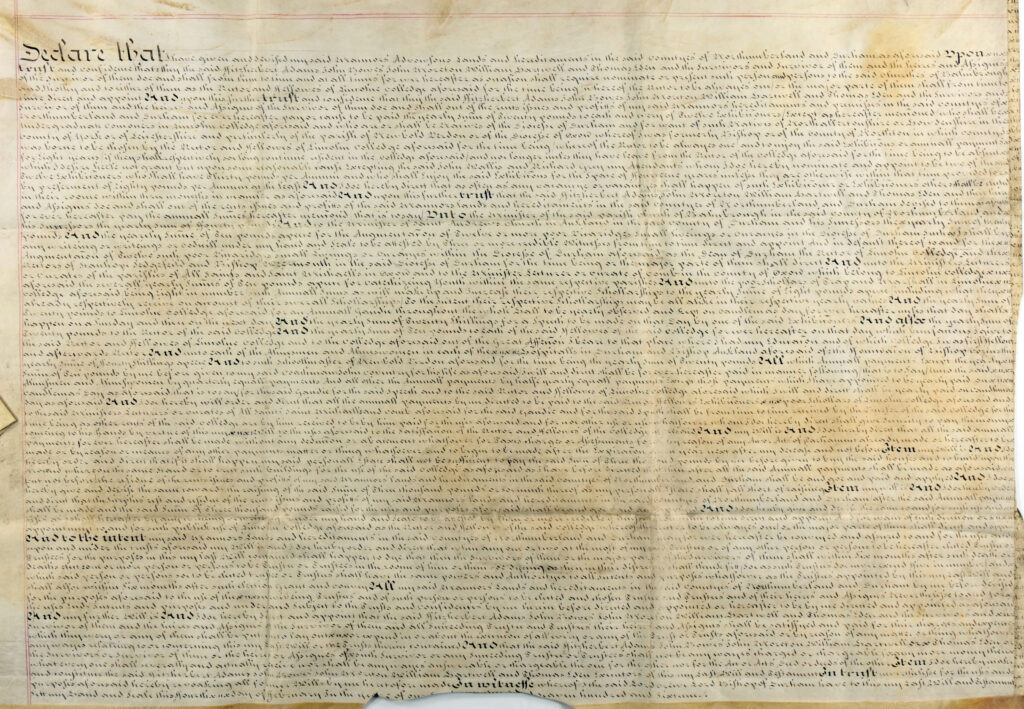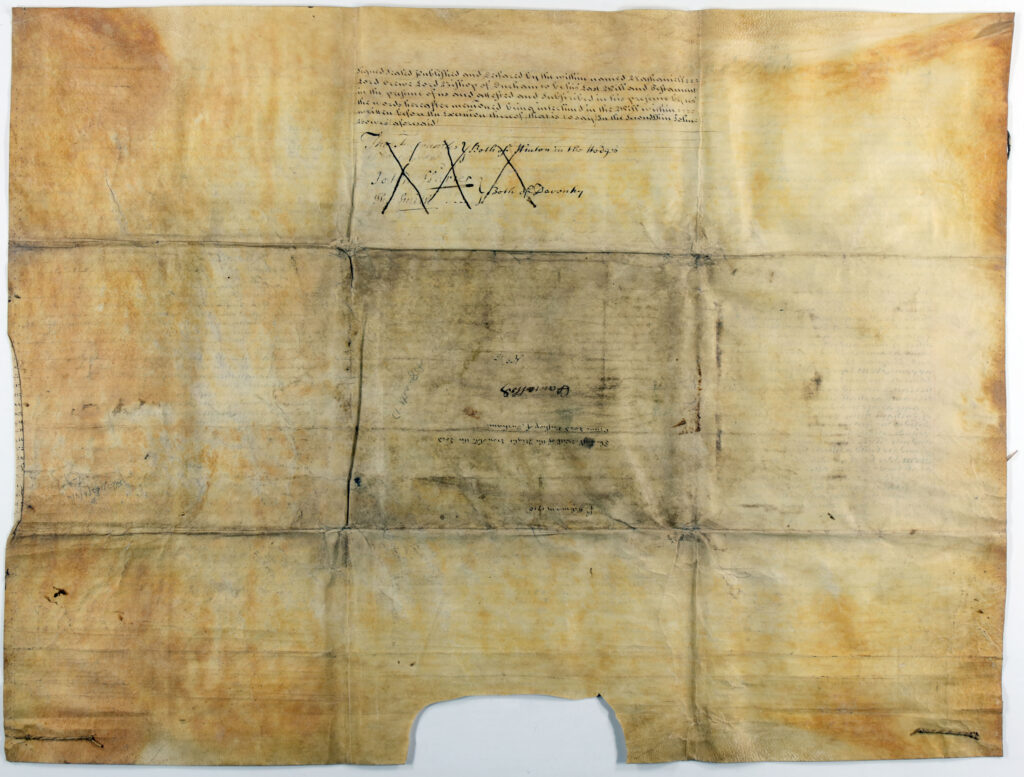NATHANIEL, LORD CREWE & LORD CREWE'S CHARITY
CONTEXT
Nathaniel Crewe (1633-1721), 3rd Baron Crewe of Steane, Northampton was the fifth of six sons to John, 1st Baron Crewe (1598-1679) and Jemima (nee Waldegrave, 1601-1675). His grandfather was Sir Thomas Crewe (1565-1634), Speaker of the House of Commons.
Following his education and academic career at Lincoln College, Oxford, Nathaniel’s ecclesiastical career rapidly advanced after he caught the attention of Charles II in 1663. He developed a close relationship with the king’s brother, the Duke of York, later James II. It was through James II’s influence that Nathaniel was elected Bishop of Durham in 1674, a position he held until his death in 1721. After James II was overthrown in 1688, Lord Crewe retreated to Durham where he was noted for his charitable works.
Nathaniel began courting Dorothy Forster of Bamburgh (1672-1715), but as he was 40 years her senior, consent was refused by her parents. After a short marriage to his first wife Penelope (1655-1699), he returned to Dorothy whom he married in 1700. Despite the age gap, it seemed to be a love match. It was through Dorothy that Nathaniel formed his deep, long-lasting connection to Northumberland. When her father Sir William Forster died in 1700, Dorothy inherited the Forster estate, including farms, mines, mills, quarries, Bamburgh Castle, and Blanchland. Upon Dorothy’s death in 1715, the estates passed to Nathaniel.
Lord Crewe’s Charity was established under the terms of the will of Nathaniel, Lord Crewe following his death in 1721, which stated that any surplus revenues derived from his estates in the north east of England should be used for charitable purposes, to be administered by five trustees. The reach of the charitable endeavours spanned the north east from Durham to north Northumberland under what was at the time the Diocese of Durham. The current Diocese of Newcastle, covering Northumberland and Tyne & Wear, came into being in 1882. Along with charitable provisions in North East England, funds were also to be given to Lincoln College, Oxford.
Since its inception, the charity has made a major contribution to the North East of England. This has involved rebuilding the medieval village of Blanchland; commissioning and operating the world’s first lifeboat; building North Sunderland (Seahouses) harbour; and setting up and running a welfare state at Bamburgh Castle, including schools, a dispensary, a granary, a fog gun to warn sailors and accommodation for those who had been shipwrecked.
The Charity continues to support Lord Crewe’s original charitable purposes. It makes payments specified under the will; supports an extensive programme of undergraduate and graduate scholarships and hardship funds at Lincoln College Oxford; makes a range of grants to clergy in the Dioceses of Durham and Newcastle; and works with a small number of partner organisations to address the needs of its beneficiaries.
The Charity still owns most of the estates left to it by Lord Crewe apart from Bamburgh Castle, sold to Lord Armstrong of Cragside in 1894 when the trustees could not afford to repair it.
Northumberland Archives holds the Charity’s archive, an excess of 12,000 documents spanning from the 15th century to the 20th century. Lord Crewe’s Charity have funded detailed cataloguing of items within the collection, with descriptions being published on the online catalogue; the digitisation of items; a virtual exhibition; and two educational modules.
For more information on the work of Lord Crewe’s Charity, visit their website: www.lordcrewescharity.org.uk
.
The school grew to become a boarding school for impoverished girls. By 1877 a larger school was established, providing space for 120 students.
DOCUMENTS
This engraved drawing of Nathaniel, Lord Crewe, was copied from an original picture in the possession of W. Bentham and was published by E. Baldwyn of Catherine Street, London. It is entitled ‘Nathl. Lord Crewe, Bp. of Durham, 1674. It is possible that the original may have been drawn to celebrate Lord Crewe’s appointment to the Bishopric of Durham in 1674. Prior to the development of photography in the 19th century, drawn or painted portraits, were important to allow the mass population access to imagery of national figures.
This portrait is located amongst the Brooks MSS amongst the records of The Society of Antiquaries of Newcastle upon Tyne. John Crosse Brooks (1812-1897) was a great collector of coins, medals, tradesmen’s tokens, pictures and engravings. The collection of autographs, for which he is best known, was begun by an uncle, and then passed on and added to by John himself ‘until it gained very considerable dimensions’. Brooks gave the 26 volumes of portraits, autographs and letters to the Society in 1894.
This is the will of Nathaniel, Lord Crewe, Bishop of Durham, made in 1720 and proven in 1721. Crewe left all the property in Northumberland and Durham, acquired from his wife’s family in trust to five men – Dr John Montagu, his nephew, and Dean of Durham; Dr Morley, the Rector of Lincoln College, Oxford; Dr Lupton, his friend, and Prebendary of Durham; Dr Eden, his chaplain and a Prebendary, and Dr John Dolben, another Prebendary (Honorary Canon).
From the revenues of this property the Trustees were bound to make the following annual payments – £20 for up to 8 years each, to 12 exhibitioners (recipients of a grant) of Lincoln College, Oxford University; an increase in their endowments to £10 for 8 poor scholars and the Bible Clerk at Lincoln College; £20 to the Rector, and £10 to each of the College Fellows. The Ministers of Bamburgh and of St Andrew’s, Bishop Auckland were to receive £40 annually, and 12 poor livings, the so called privileged livings, £10 each. In addition to some educational payments, in Oxfordshire, Buckinghamshire, and Leicestershire, Lord Crewe left £100 annually to the Mayor and Aldermen of Durham for charitable uses, £20 per annum to the Bishop Auckland schoolmaster, with £30 for clothing poor boys. £200 was to be paid annually to the University of Oxford, to be laid out according to the wishes of the Vice Chancellor; the traditional Creweian oration and Creweian tea of strawberries and champagne, given by the Vice Chancellor every Encaenia, continues to the present time.
When any of the Trustees died, the survivors were within three months to elect a successor, who had to be a clergyman; the Trustees were to be no more than five until this was amended by the nineteenth century schemes – and one was always to be the rector of Lincoln College. In addition – and most crucially for the later development of the charity in Northumberland and Durham – any surplus revenue from the former Forster estates was not to be used to increase any of the benefactions made to Lincoln College, Oxford University or the City of Durham, but for such other charitable uses as the Trustees at that time should themselves decide.
FURTHER READING
The Charities of Nathaniel, Lord Crewe and Dr John Sharp 1721-1976 by CJ Stranks published by the Dean and Chapter of Durham 1976.
Memoirs of Nathaniel, Lord Crewe edited by Rev. Andrew Clark printed for the Camden Society 1893.
The Good Sharps by Hester Grant, Penguin Random House 2020
Dilston Hall…A Visit ot Bamburgh Castle with an account of Lord Crewe’s charties etc by WS Gibson published by Longman, Brown, Green and Longmans 1850
Dorothy and the Forsters of Bamburgh by John Bird, published by John Bird 1982
Bamburgh Belford Warenmouth Spindleston Outchester by Frank Graham published by Frank Graham 1976
Lord Crewe’s Charity website: https://www.lordcrewescharity.org.uk/
Northumberland Archives exhibition on Lord Crewe’s Charity: https://northumberlandarchives.com/exhibitions/crewe/1.html
Bamburgh Research Project website: https://bamburghresearchproject.wordpress.com/
Northumberland Archives blog on the electrifying machine: https://northumberlandarchives.com/2020/05/05/the-electrifying-machine-bamburgh-castle/
BBC Free Thinking feature on Bamburgh Castle surgery: https://dralun.wordpress.com/2015/11/02/bbc-free-thinking-feature-bamburgh-castle-surgery-c-1770-1800/
Article on overcrowded and underfunded 18th century hospitals: https://dralun.wordpress.com/2014/10/06/overcrowded-and-underfunded-18th-century-hospitals-and-the-nhs-crisis/
Article on 18th century medical jobs at Bamburgh Castle: https://dralun.wordpress.com/2014/01/22/do-you-need-a-doctor-applying-for-medical-jobs-in-the-eighteenth-century/
Article on 18th century medical job wages at Bamburgh Castle: https://dralun.wordpress.com/2014/01/24/negotiating-a-pay-rise-18th-century-style/
History Today article on Bamburgh Castle infirmary and dispensary: https://www.historytoday.com/hidden-hospital-bamburgh-castle-infirmary-and-dispensary
Article on Dr John Sharp: https://www.philanthropynortheast.com/the-philanthropists/sharp-dr-john
University of Oxford Encaenia: https://www.ox.ac.uk/news-and-events/The-University-Year/Encaenia#History
Bamburgh Bones website: https://bamburghbones.org/






